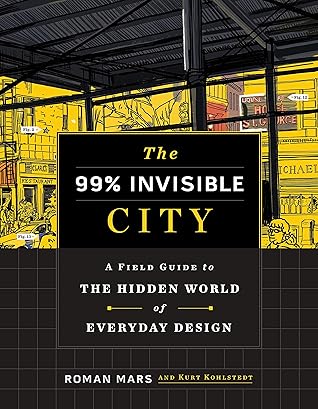More on this book
Community
Kindle Notes & Highlights
by
Roman Mars
Started reading
July 26, 2024
Most of the desire paths you encounter in a city trace the shortest distance between two points, often to cut corners, but many others are there just because people want to take a path less traveled.
Back in 1909, an article in the Calgary Herald titled “Calgary Can’t Spell” lamented prominent misspellings like Linclon and Secound Avenue etched into the sidewalks.
“workmanship such as this might be tolerated in ramshackle frontier towns, but cannot be in Calgary.”
As commercial cellular towers began to sprout up in the 1970s, diagrams depicting their coverage areas looked like blobby plant or animal cells pressed up against one another—hence the name “cell phones.”
He was useless but maintained.
Akasegawa came to have mixed feelings about using the word Thomasson to signify a useless but maintained object.
Thomassons are treasures waiting to be discovered and analyzed—whether or not they are art, they are an intriguing lens through which to look at and understand change over time.
People love love locks, but cities are often a bit more on the fence about them. In the Australian capital of Canberra, love locks were removed in 2015 for fear of weighing down a bridge; later that year in Melbourne, 20,000 locks were clipped and stripped from a bridge when cable wires began to sag under the extra weight.
Approaches like this echo the treatment of graffiti in some cities where special mural-making walls are presented as alternatives to illegal vandalism.
In England, there are tales of Royal Navy ships bringing French cannons back from the Napoleonic Wars and planting them as trophies in East London dockyards, but this reuse was actually about economics, not celebrating victories.
The aesthetic has caught on, and as a result, it can be hard to tell the real cannons from the fakes—but they are all real bollards.
Wherever there has been long-term human habitation, there are instances of spolia, from the Latin spolia, as in the “spoils” of war.
“we all accept that visual artists, writers, poets or musicians, even scholars, build their creations on the works of those before them, often incorporating and ‘reusing’ their source material.” Spolia, he suggests, have functioned in a similar fashion throughout human history.
There are five key principles of good flag design according to Kaye, many of which can also be applied to all kinds of other designs: (1) keep it simple, (2) use meaningful symbolism, (3) use two or three basic colors, (4) no lettering or seals, and (5) be distinctive or be related.
It’s not just that people love the city and therefore love the flag but also that people love the city more because the flag is so cool.
These are what vexillologists would call a SOB, short for “seal on a bedsheet.”
This misappropriation of city symbolism resulted in the hot mess that was the Pocatello flag, wherein a city marketing logo was taken out of context and plopped onto a white background, trademark symbol and all, and then declared the flag.
When city flags are done well, they are remixable, adaptable, and powerful long-term tools for civic engagement as well as sources of local pride.
This model’s very public body had come to represent truth, memory, civic fame, the stars, and even the universe in statues and sculptures. Ultimately and tragically, the inspirational figure herself was hidden away for nearly two-thirds of her life. Still, that glorious first third immortalized Audrey Munson and placed her all over American cities, observed and admired by people who largely know nothing about her. Munson is only one of many largely unknown figures with their own life stories whose likenesses have outlasted them in cities around the world.
“always read the plaque.”
it’s also another way of reminding ourselves to constantly be on the lookout for stories embedded in our built environments.
Jones’s book and others like it abstracted the ornamentation, taking it out of context and turning it into raw material for design inspiration that could be deployed in new materials and places.
When nature is rendered mathematical, something chaotic and organic is turned into something regular, comprehensible, repeatable, and ultimately beautiful.


